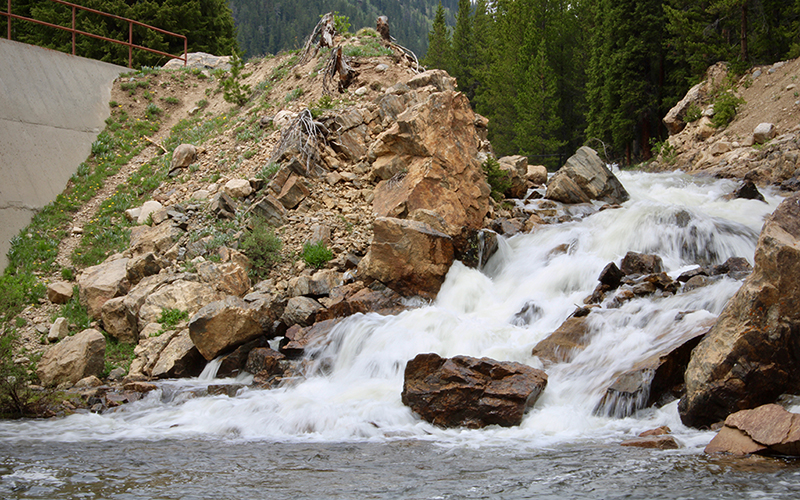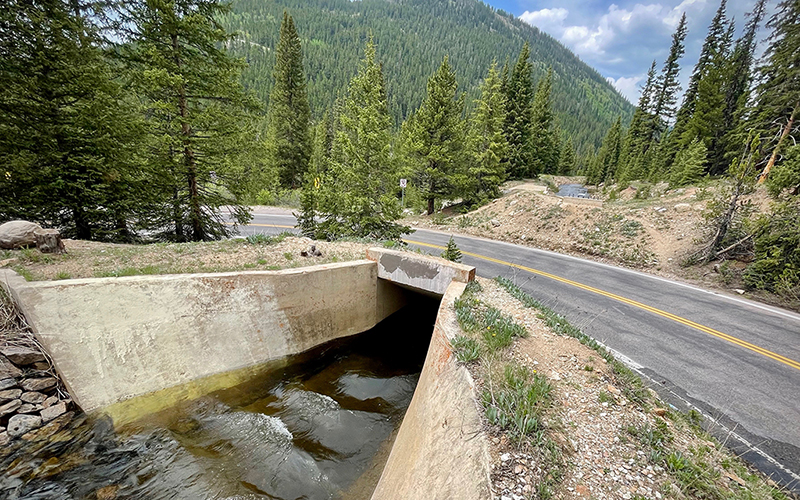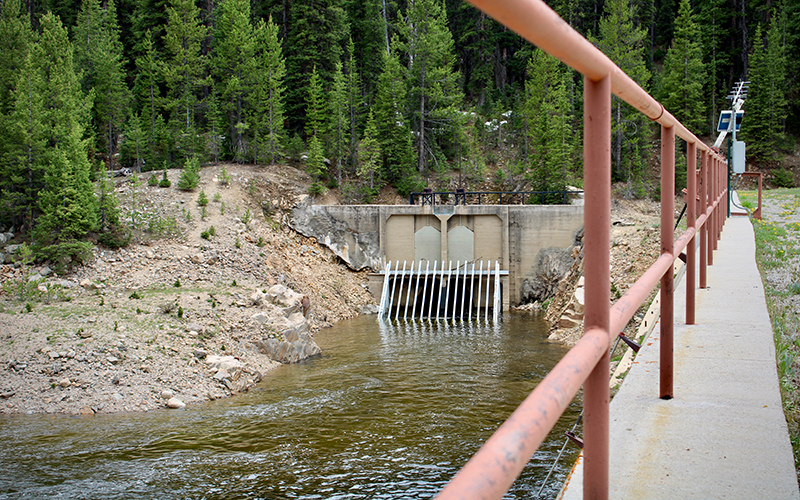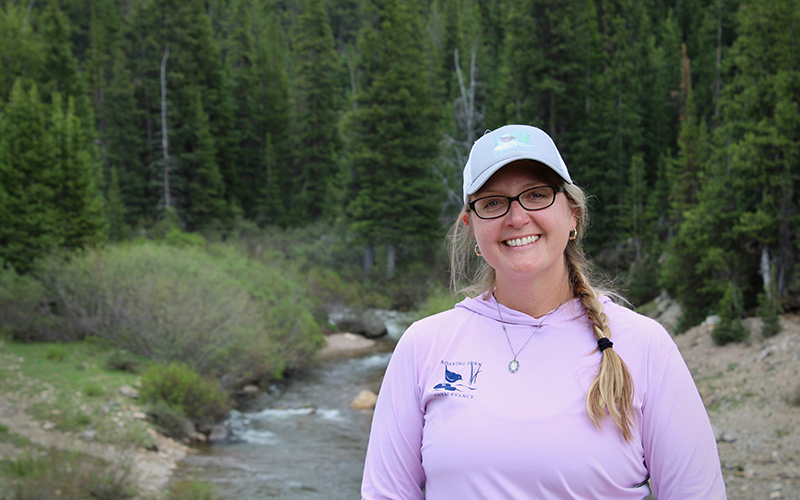
High-mountain snowmelt is collected in the Lost Man Reservoir, then channeled into a trans-mountain diversion by way of this canal. (Photo by Alex Hager/Aspen Public Radio)

Water in Lost Man Canal passes underneath State Route 82 on Independence Pass. It’s a small part of a huge plumbing system that carries high-mountain snowmelt and rainfall through Colorado’s mountains to its populated cities on the Front Range. (Photo by Alex Hager/Aspen Public Radio)

Water from the Roaring Fork River and high-mountain reservoirs combine before passing through this diversion tunnel. It will pass through two more reservoirs and the Arkansas River on its way to the Front Range. (Photo by Alex Hager/Aspen Public Radio)
High up on Colorado’s Independence Pass, a narrow, winding road weaves through the evergreens and across mountain streams, up and over the Continental Divide at more than 10,000 feet. At one point, that alpine road crosses a canal.
It’s easy to miss if you’re not looking for it, but that canal is part of the maze of water infrastructure that makes life on Colorado’s Front Range possible.
The state has a geographical mismatch between where water shows up and where much of the population has settled.
“Wherever you are in this state, you’re either the source of the drinking water supply, you’re in the middle of the drinking water supply, or you’re at the end of the tap,” said Christina Medved, outreach director at Roaring Fork Conservancy. “So on the Western Slope, we’re at the source of the water.”
About 80% of Colorado’s water falls on the western side of the state. Much of it is high-mountain snow and rain that eventually trickles into streams and rivers, like those near Independence Pass.
But about 80% of Coloradoans live east of the Rocky Mountains, and because of gravity, that water doesn’t flow to them naturally. Instead, Colorado’s Front Range relies on an enormous plumbing system to keep drinking water flowing to its taps.
For a century and a half, engineers have carved up the mountains with tunnels and canals that pipe water across the state through trans-mountain diversions. Some of that infrastructure is nestled near the high-alpine headwaters of the Roaring Fork River, which eventually flows through Aspen and Glenwood Springs on its way to the Colorado River. Near Lost Man Reservoir, a dam and tunnel create a juncture separating water that will follow that natural path westward to the Colorado and water that will be diverted eastward through the mountains and down to Colorado Springs and other cities.
A tunnel through the Rockies draws in water that will pass through two reservoirs and the Arkansas River on its way to the southern portion of the Front Range. Water diverted from the Colorado River Basin through trans-mountain diversions makes up 60% to 70% of the water used by Colorado Springs. Denver, Greeley, Fort Collins and smaller municipalities on the Front Range also rely heavily on Western Slope water.
And these kinds of setups aren’t unique to Colorado; similar systems bring water to big cities all across the region. In Arizona, the Central Arizona Project brings Colorado River water hundreds of miles to the Valley. Salt Lake City, Albuquerque and Los Angeles rely on canals and tunnels to ship faraway water into their pipes. New ones are in the works on the Front Range and in southern Utah.
But these systems have critics.
“When you first learn about it, the concept of a trans-mountain diversion is crazy,” said Andy Mueller, general manager of the Colorado River Water Conservation District. “It seems wrong. It seems antithetical to the health of the river. And I have to say all of that’s true.”
The organization he manages was set up in the 1930s to oppose such diversions and ensure there’s enough water for people on the western side of the state.
“The idea that a large population center hundreds of miles away can pull water out of a stream and bring it to their city for their use is hard to accept under the current ecological and environmental values that our society holds,” Mueller said.
But contemporary environmental values aren’t written into water law in the West. Instead, water use is defined by regulations written when Colorado first became a state in the 1800s. The rules say that if you have rights to use water, it doesn’t matter where you use it – even if that requires miles of cross-mountain plumbing to do so.

“You’re either the source of the drinking water supply, you’re in the middle of the drinking water supply, or you’re at the end of the tap,” says Christina Medved with the Roaring Fork Conservancy. (Photo by Alex Hager/Aspen Public Radio)
At this moment, there is less water to pull from across the state. The Front Range escaped from drought after steady spring rains, but those high-mountain areas that usually provide a dependable source of water for all of Colorado are experiencing a different fate. The Western Slope is deep in the second year of drought conditions, leaving snowpack and river flows lower than they should be.
Mueller thinks that only sharpens the need for Front Range cities to curtail water use. Although they retain the legal right to use a certain amount of water, he’s asking them to use less – which he says will promote the health of rivers and their ecosystems west of the Continental Divide.
On the Front Range, those on the receiving end of diversions say they are listening to their western counterparts during particularly difficult times. They also say deliberate conservation work is paying off in the longer term. Nathan Elder, water supply manager for Denver Water, said over the past two decades, per capita water use in his district is down by 22%.
“Everyone in Colorado needs to decrease their use,” he said. “We have seen that. And we have been successful with our conservation efforts and customer messaging and watering rules.”
Amid tension between demands for water on both sides, exacerbated by extreme drought conditions, is the fact that there isn’t much of an alternative. Colorado’s water system is built to accommodate the fact that the majority of its people and the majority of its water are far from each other. Without fundamental changes to the bedrock of water law, those asking for water will have to work within a system built on trans-mountain diversions.
“You can’t sustain one without the other,” Elder said. “It has to work together with water from the west slope moving over to the east slope. Because I don’t see picking up the population and moving the people over to the west slope.”
Some contingency planning – within the reality of a diversion-centric system – already is in place. In Colorado Springs, which receives some of the flow diverted from the top of Independence Pass, reuse practices are helping the city get more mileage out of the water it’s apportioned.
Abby Ortega, water resources manager for Colorado Springs Utilities, said reused water accounts for 26% of the city’s total portfolio, and the city relies heavily on storage to get through dry years like this one.
But climate change threatens to increase the frequency and intensity of droughts, which has water managers on edge and looking more intently at ways to maximize what’s available.
“Every water planner in the state has some worry with the rapidly declining hydrology on the Colorado River,” Ortega said. “I would be silly if I didn’t say that I was worried.”
This story is part of ongoing coverage of the Colorado River, produced by Aspen Public Radio, distributed by KUNC and supported by the Walton Family Foundation.